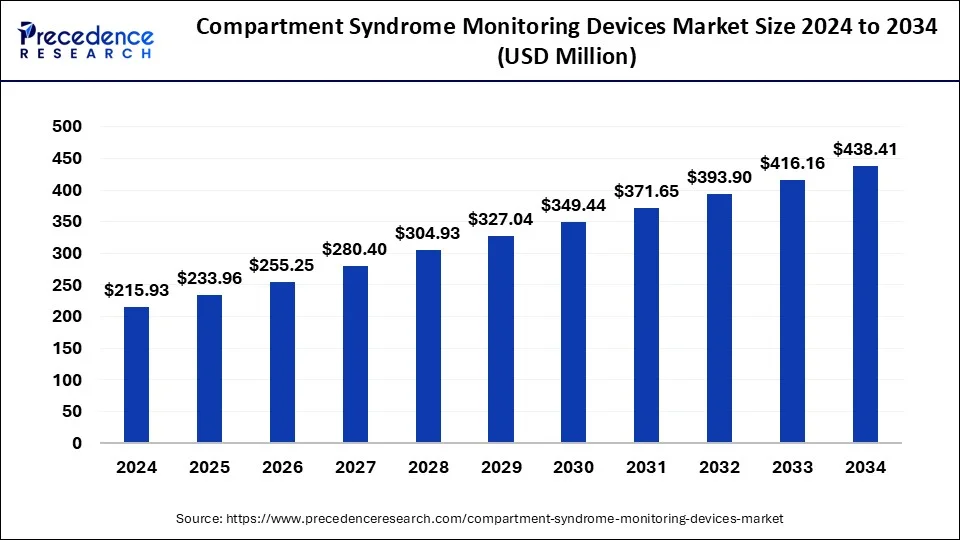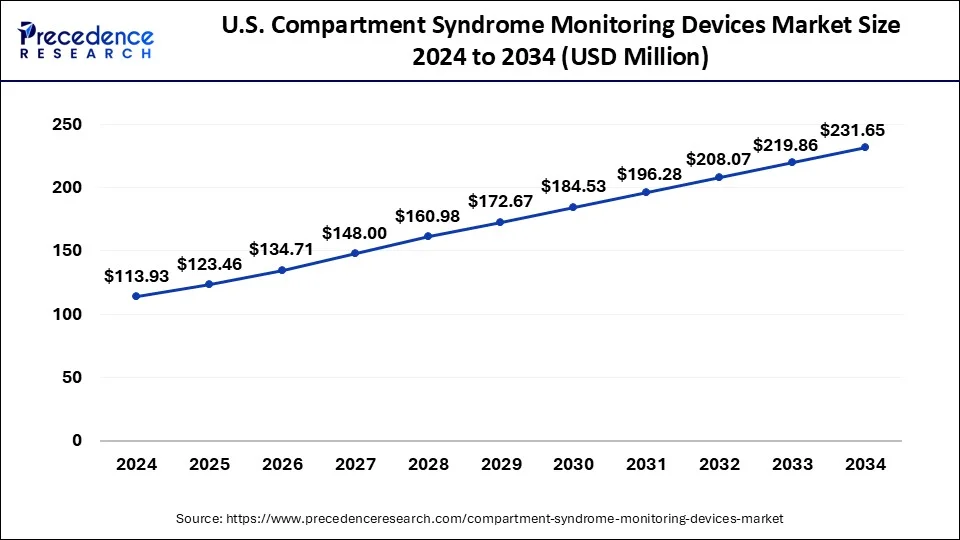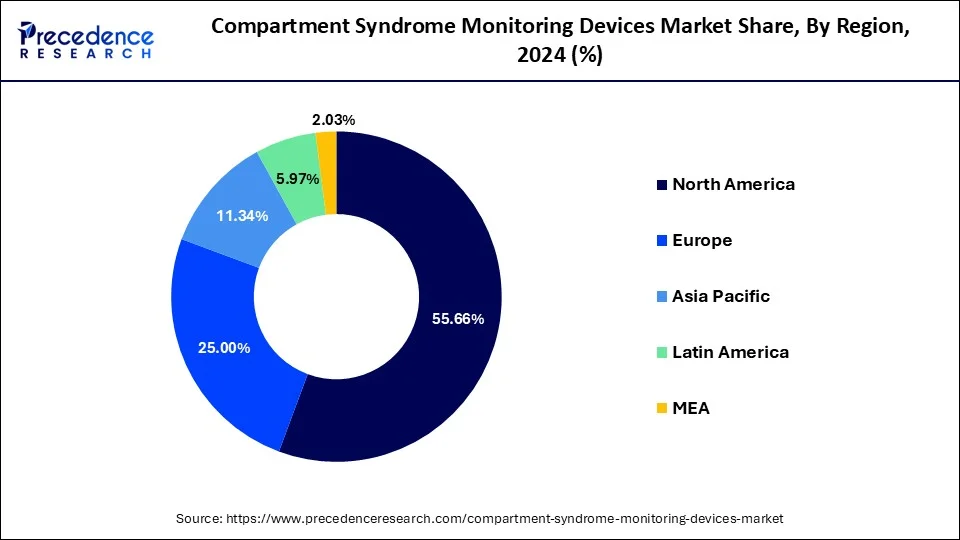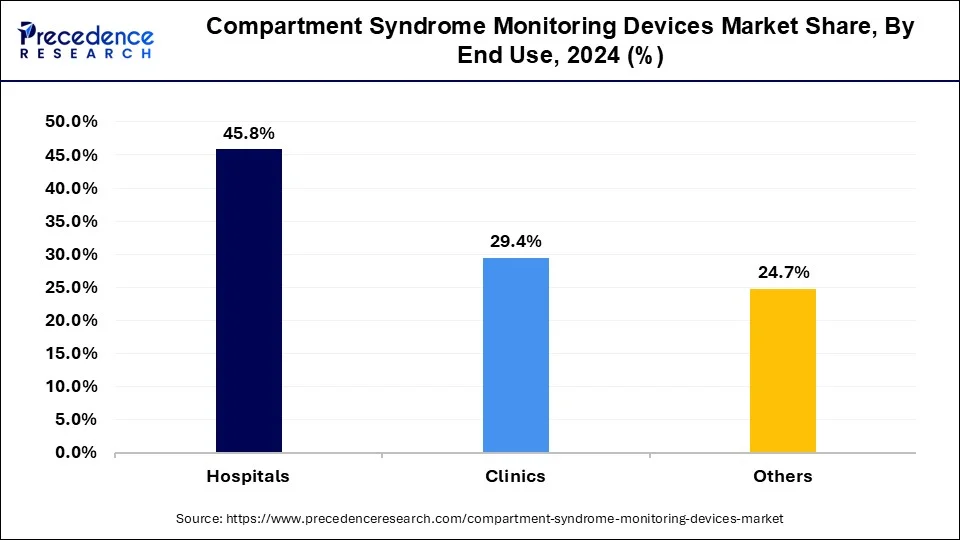May 2024
Compartment Syndrome Monitoring Devices Market (By Product: Disposables, Equipment; By Syndrome Type: Acute Compartment Syndrome, Chronic Compartment Syndrome, Abdominal Compartment Syndrome; By End-use: Hospitals, Clinics, Others) - Global Industry Analysis, Size, Share, Growth, Trends, Regional Outlook, and Forecast 2024-2033
The global compartment syndrome monitoring devices market size was valued at USD 204.35 million in 2023 and is anticipated to reach around USD 423.12 million by 2033, growing at a CAGR of 7.55% from 2024 to 2033. The compartment syndrome monitoring devices market is driven by an increase in intra-abdominal hypertension rate.

The U.S. compartment syndrome monitoring devices market size reached USD 80.11 million in 2023 and is predicted to be worth around USD 165.86 million by 2033 at a CAGR of 7.60% from 2024 to 2033.

North America had a dominating market share of 56% in 2023. The prevalence of trauma-related injuries, diabetes, and peripheral vascular disease are among the chronic illnesses that immensely increase the risk of compartment syndrome. Monitoring tools that can help with the early diagnosis and treatment of compartment syndrome in patients with underlying medical conditions are becoming more necessary. Additionally, the adoption of cutting-edge medical technologies, such as compartment syndrome monitoring devices, is made possible by expenditure on healthcare. These gadgets are widely available and in high demand, since healthcare professionals and facilities are well-equipped to make the necessary investments.

Asia-Pacific is observed to be the fastest growing in the compartment syndrome monitoring devices market during the forecast period.
Advances in healthcare infrastructure and medical professional education and training have raised awareness of illnesses such as compartment syndrome. Due to increased awareness, there is a greater need for monitoring tools to precisely measure and track intracompartmental pressure, enabling medical professionals to make prompt clinical judgments. Policies that enhance healthcare affordability, quality, and accessibility frequently incorporate provisions for cutting-edge medical technologies and equipment.
As a result, there are now chances for producers and distributors of compartment syndrome monitoring equipment to grow into new markets and form important alliances with medical facilities.
Compartment Syndrome Monitoring Devices Market Overview
The compartment syndrome monitoring devices market revolves around the production, innovation and distribution of devices and solutions that are used to continuously measure and track the pressure inside the body's muscle compartments. These gadgets' main objective is to identify and stop the onset of compartment syndrome, a dangerous illness marked by elevated pressure inside a muscle compartment that can cause tissue damage, decreased blood flow, and nerve compression. These gadgets assist in preventing consequences like muscle necrosis, nerve damage, and decreased limb function that are linked to untreated compartment syndrome by continuously monitoring compartment pressures.
These monitoring devices enhance patient outcomes through the promotion of prompt diagnosis, appropriate management, and timely intervention in the event of compartment syndrome. This lowers the likelihood of long-term complications, enhances limb function, and speeds up overall recovery.
| Report Coverage | Details |
| Growth Rate from 2024 to 2033 | CAGR of 7.55% |
| Global Market Size in 2023 | USD 204.35 Million |
| Global Market Size by 2033 | USD 423.12 Million |
| U.S. Market Size in 2023 | USD 80.11 Million |
| U.S. Market Size by 2033 | USD 165.86 Million |
| Base Year | 2023 |
| Forecast Period | 2024 to 2033 |
| Segments Covered | By Product, By Syndrome Type, and By End-use |
| Regions Covered | North America, Europe, Asia-Pacific, Latin America, and Middle East & Africa |
Drivers
Increasing emphasis on patient safety and outcomes
By facilitating proactive care of compartment syndrome, monitoring devices have a substantial positive impact on patient outcomes. Early treatments based on precise measures of pressure aid in avoiding consequences such nerve injury, muscle necrosis, and functional impairment. For patients with acute injuries, long-term illnesses, or post-operative problems, these devices help better recovery trajectories, shorter hospital stays, and better overall outcomes by maintaining optimum compartment pressures. Thereby, the rising emphasis on patient safety and outcomes creates a major driver for the compartment syndrome monitoring devices market.
Growing awareness among healthcare providers
Individuals who have experienced catastrophic injuries, like fractures or crush injuries, are especially vulnerable. Athletes and people who participate in high-intensity physical activities are also at risk of compartment syndrome. Healthcare professionals are growing more alert as these populations continue to expand, keeping an eye out for compartment syndrome symptoms. Technological developments in medicine have also been significant in raising awareness of and encouraging the use of compartment syndrome monitoring equipment.
Innovative sensors and algorithms are used by modern monitoring systems to continuously detect factors like tissue oxygenation, temperature, and pressure within damaged muscle compartments. These gadgets give medical professionals access to real-time data and warnings, facilitating prompt compartment syndrome treatment and intervention.
Restraint
High cost of advanced monitoring devices
The costs of cutting-edge monitoring equipment may not be covered by reimbursement rates for compartment syndrome monitoring methods in healthcare systems or geographical areas. Healthcare providers may be deterred from purchasing these devices by this disparity between technological costs and reimbursement rates, especially if they expect to have financial difficulties in recovering their investment. Advanced monitoring equipment must be calibrated, maintained, and cleaned regularly after the initial purchase.
Software upgrades, sensor replacements, and technical assistance are a few examples of these recurring expenses. It becomes more difficult for some healthcare providers to maintain these devices over time due to the cumulative costs that increase the total cost of ownership.
Opportunities
Innovation in sensor technologies
When combined with sophisticated analytics and machine learning algorithms, sensor data can provide insights into trends and patterns that could point to the beginning of compartment syndrome or anticipate risk factors unique to a given patient. Personalized treatment plans and preventative actions are made possible by this proactive approach. The use of wireless connectivity facilitates the smooth transfer of data from sensors to healthcare practitioners' devices or monitoring systems. This feature facilitates remote monitoring, which is particularly helpful in telemedicine circumstances as it enables medical teams to evaluate patients' symptoms from a distance and act quickly when needed.
Expanding healthcare infrastructure in emerging markets
The expansion of healthcare facilities is accompanied by the incorporation of sophisticated medical technology. Devices for monitoring compartment syndrome have advanced dramatically, adding features like wireless communication, real-time monitoring, and more precise pressure readings. Higher adoption rates among healthcare professionals are a result of emerging markets' acceptance of these technological improvements. Healthcare practitioners and the public are becoming more aware of complex medical diseases like compartment syndrome in tandem with the improvement of the healthcare infrastructure.
The equipment segment dominated the compartment syndrome monitoring devices market in 2023 and is observed to sustain the position throughout the forecast period. The increased cost of healthcare around the world has given healthcare facilities more money to spend on cutting-edge medical technology, such as compartment syndrome monitoring equipment. Modern equipment purchase is becoming a top priority for hospitals and clinics to boost operational effectiveness and improve patient care results. Due to ongoing technical developments, sophisticated monitoring devices with improved capabilities have been developed.
Integrated wireless communication, real-time data analysis, and enhanced pressure measurement accuracy are some of these developments. These advancements draw medical professionals looking for cutting-edge compartment syndrome monitoring systems.
The disposables segment is observed to be the fastest growing in the compartment syndrome monitoring devices market during the forecast period. As single-use devices are easy to use and sterile, they are preferred in some medical procedures and applications. Disposable devices that may be safely inserted and removed without jeopardizing patient safety or device integrity are generally advantageous for compartment syndrome monitoring, which entails continual tissue pressure monitoring to prevent ischemia damage. Disposable devices provide a safe and hygienic solution given the increased focus on infection prevention and control.
Strict cleaning and sterilizing procedures are needed for reusable devices to avoid patient cross-contamination. Disposable devices, on the other hand, are meant to be used just once before being thrown away, which lowers the possibility of infection or pathogen transmission between patients. In critical care settings, where patients are vulnerable to infections, this trait is extremely important.
The abdominal compartment syndrome (ACS) segment dominated the compartment syndrome monitoring devices market in 2023. Abdominal compartment syndrome (ACS) has become more commonplace worldwide because of several conditions, including critical illness, sepsis, trauma, and surgery. The demand for efficient monitoring tools to treat ACS patients grows as more instances are identified. Owing to developments in medical technology, novel monitoring devices with improved accuracy, dependability, and user-friendliness have been created.
The hospitals segment dominated the compartment syndrome monitoring devices market in 2023. Hospitals are the main care facilities for various illnesses, including trauma injuries that may result in compartment syndrome. This disorder develops when blood flow is hampered by elevated pressure inside a muscle compartment, which may cause tissue injury and other issues. Comprehensive patient care is given priority, including the monitoring and treatment of illnesses that, if left untreated, may have dire repercussions.
One such disease that requires constant observation to avoid complications like tissue necrosis and irreversible damage is compartment syndrome. To guarantee that patients receive the best treatment possible during their hospital stay, from initial assessment to post-operative management, hospitals make investments in monitoring devices.

The clinics segment is observed to grow at the fastest rate in the compartment syndrome monitoring devices market during the forecast period. Since these devices can precisely measure and track intercompartmental pressures, compartment syndrome monitoring technology is quickly becoming a vital component of these clinics' medical equipment inventories. The need for monitoring devices in clinics is being driven by the increased frequency of illnesses such as traumatic injuries, fractures, and vascular disorders that might result in compartment syndrome. Clinics are under pressure to offer comprehensive diagnostic and monitoring services, including for illnesses like compartment syndrome, as an increasing number of patients seek care in outpatient settings.
New gadgets with better features including wireless connectivity, real-time monitoring capabilities, and increased precision are constantly being introduced by manufacturers. These developments raise adoption rates by making the gadgets easier to utilize in clinical settings for medical practitioners.
Segments Covered in the Report
By Product
By Syndrome Type
By End-use
By Geography
For inquiries regarding discounts, bulk purchases, or customization requests, please contact us at sales@precedenceresearch.com
No cookie-cutter, only authentic analysis – take the 1st step to become a Precedence Research client
May 2024
March 2025
January 2025
January 2025